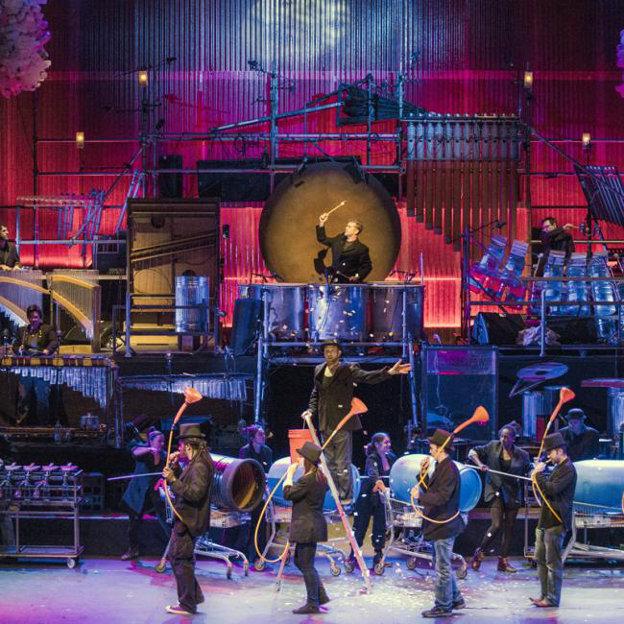As we enter the Dome’s auditorium our eyes are drawn to the colourfully lit stage featuring a multi-level scaffolding construction with industrial tubing arranged like church organ pipes, numerous giant wooden marimbas, a full set of plastic building site barrel timpani, and an array of Heath Robinson-esque apparatus waiting to reveal its purpose. The lights dim and a troupe of musicians take to the stage carrying cello cases which are played, unopened, as percussion instruments. And so starts The Lost and Found Orchestra…
The show has had quite a journey to this point. Created by Luke Cresswell and Steve Nicholas (of Stomp fame), it was first commissioned for the 2006 Brighton Festival and has undergone many and various changes whilst touring the world, now coming back full circle to Brighton. Having seen that original 2006 production, I was eager to see how much the show had changed and developed over the intervening six years.
The format, for the most part, is an orchestral performance – musicians on the scaffold playing instruments which remain fixed for the duration of the show – teamed with upbeat physical performance from a group of dancer/percussionists (the Stomp regulars) at stage-level who carry, push or ride around in instruments made from domestic junk and industrial waste. Garden hoses, shower units, carpet cleaners, bicycle bells, and bellows all have their moment. Each piece of music has a different selection of portable instruments played by the stage-level performers, which sets the theme and mood, and sometimes suggests a narrative of sorts. As an example: traffic cones used as trumpets (dubbed ‘plumpets’) and concrete-mixer percussion create the feel of a noisy roadworks scene.
Many of these makeshift instruments played by the physical performers form multiple parts within which each performer has his or her own individual note, the tune being made by each playing their note in sequence – an example being the ‘squonkaphones’, made from pipes of various length with balloons stretched over the end. This leads to a very energetic visual performance, displaying a high level of coordination and synchronisation, but the downside is the somewhat stilted and limited musical performance, which reminded me of Spike Milligan’s national anthem where each note is played by a different instrument – very funny, but soon gets jarring.
Character and personality are left mostly to the instruments – the exception being a solitary clown who stumbles around, weaving in and out of the other performers trying to join in. He is given very little space, and much of what he does is hard to see, crowded out as he is by the energetic jumping and running around of the other performers. The few times he was allowed the spotlight, the show gained some much needed heart and soul.
Cresswell and Nicholas made a very brave decision to move away from purely percussive playing, to explore the possibilities of harmony and musical innovation on found objects and specially constructed instruments. The engineering and inventiveness of the instruments and the standard of musicianship (for the most part) are excellent. Favourite pieces included: the home-made glass armonium – the most magical sound in the world, played in the same way as you would a glass, by rubbing a wet finger on the rim, except that this ‘glass’ has a full two or three octaves; the double-bass bed, in which the base of a bed turns into a stringed instrument; and the chorus of musical saws played delicately and harmoniously in tune (which is much harder than you might think).
It is in its theatrical elements that Lost and Found falls short. The original show had a great deal more oddball quirkiness and gentleness, and it has been noticeably ‘Stomp-ified’ over the years: there was a good deal less of the typical Stomp street percussion in the earlier version, and a less fixed, more theatrical set. One of the highlights of the 2006 show saw renowned circus performer Lindsey Butcher and other aerialists flying high across the stage on ropes that sounded bells and gongs. No doubt the current version of the show is more tourable – and more marketable to Stomp fans and to venues looking for ‘Stomp part 2’ – which is maybe a good commercial decision, but detracts from the odd and eccentric personality the original Lost and Found Orchestra had.
There is a growing trend for productions to mix live music and theatrical performance in equal balance. Done well – for example, in Zic Zazou’s Brocante Sonore: The Mechanicians, a show which also features an orchestra of junk and found instruments – the show is greater than the sum of its parts. In Lost and Found Orchestra there are very many beautiful and interesting parts, yet the sum of the whole somehow falls short of those inspiring parts.


